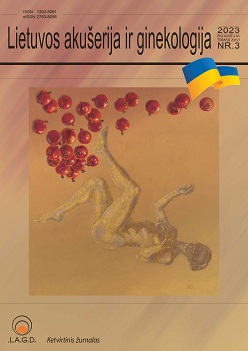FIRST EXPERIENCE IN USING DUOSTIM OVARIAN PHASE STIMULATION IN PATIENTS UNDERGOING ASSISTED REPRODUCTION
Abstract
The aim. To evaluate characteristics of the ovarian stimulation, laboratory indicators of assisted reproduction procedures and treatment outcome of the patients afterDuoStim ovarian stimulation before assisted reproduction (AR). Material and methods. A retrospective study was conducted at LSMU Kaunas Clinics, Reproductive Medicine Center in 2020–2022. The study group consisted of patients who received a modified DuoStim protocol for ovarian stimulation before the AR. Oral estradiol was prescribed for follicle synchronization, gonadotropins were used for ovarian stimulation during follicular phase (FP) and luteal phase (LP). Ovum pick-up was performed after FP and LP ovarian stimulation. The duration of ovarian stimulation, the number of oocytes obtained, fertilization rates, blastocyst formation, and their morphological quality were evaluated. Embryos were cultured until blastocyst stage and were cryopreserved. The frozen-thawed blastocyst was transfered into the uterine cavity in subsequent cycle after endometrium preparation with hormone replacement therapy. Clinical pregnancy indicators and pregnancy outcomes were assessed. Results. DuoStim ovarian stimulation was applied to 10 women that were assigned to the POSEIDON groups. Duration of ovarian stimulation in FP and LP did not differ significantly (11.2 and 11.3 days; SD 1.7 and 2.2). More oocytes were aspirated after stimulation in LP than after FP (4.9 vs. 2.8 oocytes; SD 2.5 vs. 0.98). After stimulation in LP, better oocyte fertilization was observed compared to FP (78.5 and 60.8%; SD 26.6 and 41.5) and a better blastulation rate (40.7 and 25%; SD 35.5 and 33.5). A clinical pregnancy was established in 6 of 10 patients, and 4 of 10 patients had successful delivery. Conclusion. The DuoStim method of ovarian stimulation can be successfully used in patients with poor prognosis, hoping for a higher number of retrieved eggs and more favorable results of the AR procedure.

